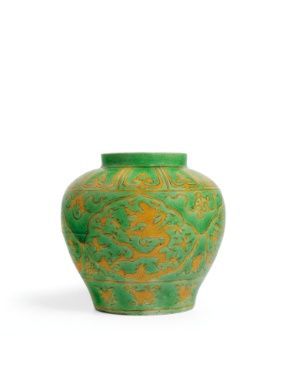An incised green-ground yellow-enamel 'dragon' jar. Mark and period of Wanli
An incised green-ground yellow-enamel 'dragon' jar. Mark and period of Wanli - Photo Sotheby's
PROVENANCE: Sotheby’s Hong Kong, 30th April 1996, lot 360.
Eskenazi Ltd, London.
LITTERATURE: Regina Krahl, Chinese Ceramics from the Meiyintang Collection, London, 1994-2010, vol. 4, no. 1692.
NOTE DE CATALOGUE: Jars decorated in this striking colour combination are rare in private collections but are found in several major museums, for example, in the Tokyo National Museum from the Yokogawa collection, in the Metropolitan Museum of Art, New York, and in the British Museum, London, from the Oppenheim collection, all illustrated in Oriental Ceramics: The World's Great Collections, Tokyo, New York, and San Francisco, 1980-82, vol. 1, no. 124; vol. 5, no. 206, and vol. 11, no. 96; other examples are illustrated in Geng Baochang, Ming Qing ciqi jianding [Appraisal of Ming and Qing porcelain], Hong Kong, 1993, col. pl. 73; in John Ayers, The Baur Collection Geneva: Chinese Ceramics, Geneva, 1968-74, vol. II, no. A 208; and in Idemitsu Bijutsukan zhin zuroku: Chgoku tji/Chinese Ceramics in the Idemitsu Collection, Tokyo, 1987, no. 766. Two other jars with a coarser version of this design, from the Eumorfopoulos collection in the British Museum, London, are illustrated in Jessica Harrison-Hall, Ming Ceramics in the British Museum, London, 2001, pls. 11: 174 and 175.
A rare covered example in the Palace Museum, Beijing, is illustrated in Yeh Pei-lang [Ye Peilan], Beauty of Ceramics, vol. 7: Gems of the Wucai Porcelain, Taipei, 1996, pl. 160.
Sotheby's. The Meiyintang Collection, Part IV - An Important Selection of Imperial Chinese Porcelains. Hong Kong | 09 oct. 2012 www.sothebys.com

/https%3A%2F%2Fprofilepics.canalblog.com%2Fprofilepics%2F1%2F0%2F100183.jpg)
/https%3A%2F%2Fstorage.canalblog.com%2F03%2F02%2F119589%2F96711876_o.jpg)
/https%3A%2F%2Fstorage.canalblog.com%2F11%2F31%2F119589%2F94773502_o.jpg)
/https%3A%2F%2Fstorage.canalblog.com%2F20%2F83%2F119589%2F94772815_o.jpg)
/https%3A%2F%2Fstorage.canalblog.com%2F26%2F72%2F119589%2F75604929_o.jpg)
/https%3A%2F%2Fstorage.canalblog.com%2F59%2F60%2F119589%2F26458628_o.jpg)




/http%3A%2F%2Fstorage.canalblog.com%2F03%2F39%2F119589%2F112863997_o.jpg)
/http%3A%2F%2Fstorage.canalblog.com%2F62%2F48%2F119589%2F112863681_o.jpg)
/http%3A%2F%2Fstorage.canalblog.com%2F70%2F18%2F119589%2F112863572_o.jpg)
/http%3A%2F%2Fstorage.canalblog.com%2F18%2F21%2F119589%2F112863015_o.jpg)